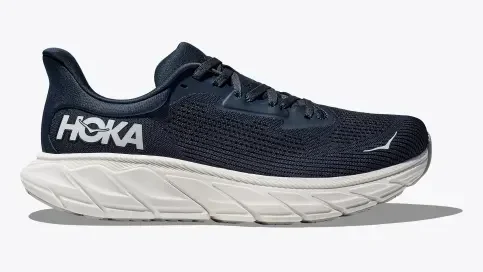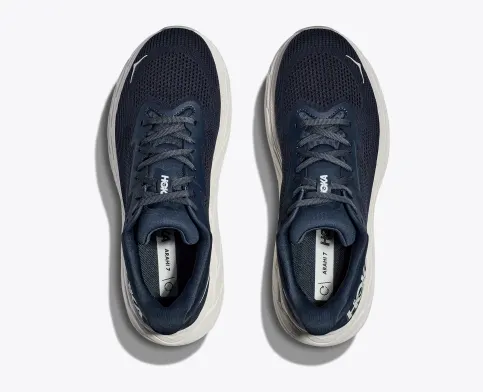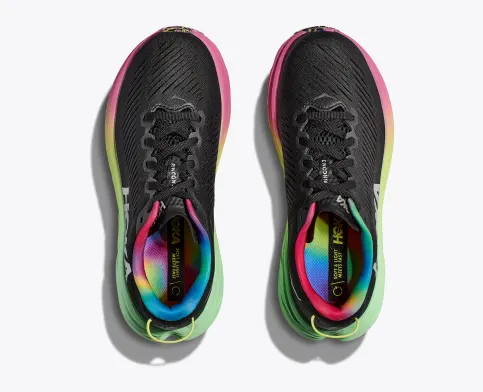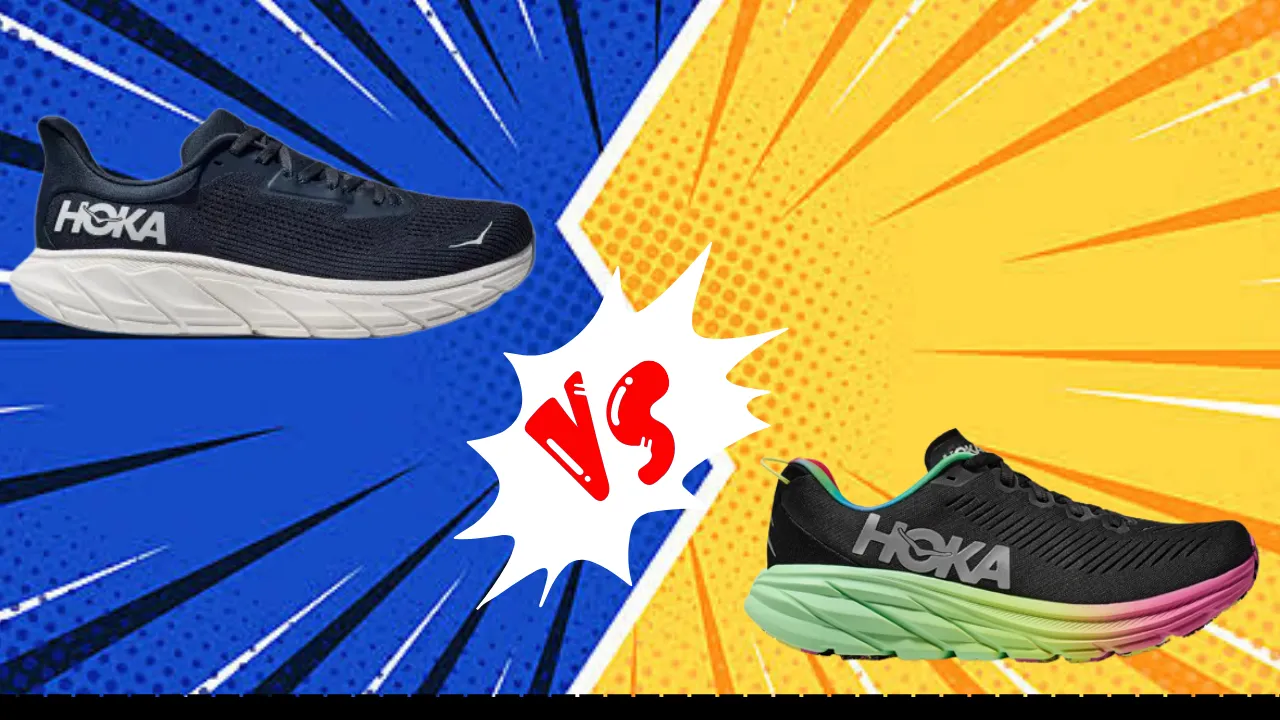If you’re a runner searching for your next pair of shoes, you may be trying to decide between the Hoka Arahi 7 and the Hoka Rincon 3.
Both are popular stability running shoes from Hoka One One, but they have key differences that may make one better suited for your needs.
This in-depth comparison covers all the nitty gritty details on cushioning, fit, stability, durability and more to help you choose the best Hoka shoe for you. Read on to learn which model comes out on top!
Similarities And Differences Between Arahi 7 And Rincon 3:
| Feature | Hoka Arahi 7 | Hoka Rincon 3 |
|---|---|---|
| Launched In | 2024 | 2021 |
| Stability | Moderate | Neutral |
| Flexibility | Moderate | Moderate |
| Sizing | Men’s 7-13, Women’s 5-11 | Men’s 7-13, Women’s 5-11 |
| Weight | 9.5 oz (M), 8.7 oz (W) | 7.5 oz (M), 6.8 oz (W) |
| Cushioning | Moderate | High |
| Outsole | Zonal rubber | Zonal rubber |
| Midsole | J-Frame, CMEVA foam | CMEVA foam |
| Upper | Mesh | Mesh |
| Retail Price | $145 | $125 |
Features Comparison:
Materials:
The Arahi 7 constructs its upper with breathable mesh and strategic synthetic overlays that provide structure around the midfoot and eye stays.
Underfoot, it uses a dual-density midsole, with softer CMEVA foam up top for cushioning and the firmer J-Frame support technology on the bottom to prevent excessive inward foot rolling while running.


On the outsole, zonal high-abrasion rubber is strategically placed in areas that typically experience more wear for improved durability in key zones.
In contrast, the Rincon 3 features an engineered mesh upper made to hug the foot in comfort, while allowing airflow to keep feet cool and dry.
The simplified single-density midsole is composed of soft, responsive CMEVA foam from heel to toe aimed at delivering an energetic ride. The outsole also employs zonal rubber placement but relies more heavily on exposed foam areas for weight reduction.
Durability:
The Arahi 7 is built to last, with reinforcements to the upper and a substantial outsole rubber coverage contributing to moderate durability. The midsole’s dual-density construction also maintains cushioning and support over extended use.
While the Rincon 3 has improved its lifespan over previous versions, it is still not as durable as shoes designed for higher mileage training. The exposed foam and lack of stability technology mean it will lose some pop and structure sooner than the Arahi 7. For long-term wear, the Arahi 7 is the more durable pick.
Fit:
Both shoes fit true to size for most runners, but achieve their secure lockdown in different ways. The Arahi 7 employs synthetic overlays through the midfoot to firmly grip and support the foot during motion. It also has a moderately spacious toe box to allow natural toe splay while running.


The Rincon 3 uses a seamless engineered mesh upper that adapts to the foot for a dynamic, foot-hugging fit. There is no right or wrong here, just personal preference on the upper feel. Both accommodate a variety of foot shapes.
Stability:
One of the Arahi 7’s primary functions is to provide stability and support, making it an excellent choice for overpronators. The midsole’s J-Frame technology is specially designed to prevent excessive inward rolling of the foot, while guide rails on the outsole also help control pronation.
Meanwhile, the Rincon 3 offers no pronation correction technology or features, performing best for neutral runners without support needs.
Cushioning:
Plush softness underfoot is where the Rincon 3 shines. Its high-volume compressed midsole foam delivers an exceptional step-in feel and continues cushioning mile after mile.
The Arahi 7 offers cushioning a notch below – ample for comfort, but not as pillowy as the Rincon 3. However, the Arahi 7 also provides stability components the Rincon lacks, demonstrating tradeoffs between plushness and support.
Value:
Considering the technology and construction, both shoes deliver good value at around $125-145.
The Arahi 7 does come at a slight premium for its stability features like the dual-density midsole and pronation-preventing J-Frame, worthwhile for overpronators. Yet the Rincon 3 impressively packages a lightweight, cushioned ride into an affordable price point. Determine your must-have features and pick the shoe that aligns with your priorities to maximize value.
Performance Comparison:
Walking:
As an all-around walking shoe, the Rincon 3 excels with its easy flexibility and abundant cushioning to keep your stride comfortable across long distances. However, the Arahi 7 is no slouch either, providing ample underfoot padding though the pronounced stability elements feel somewhat stiff.
For walking comfort straight out of the box, the Rincon 3 is tough to beat. Its soft midsole and smooth heel-to-toe transition help your feet stay happy for hours of wear.
Running:
The Rincon 3 shines when picking up the pace, with its energetic ride and snappy toe-off catering to faster paces. Neutral runners will love its lightweight package and a barely-there feel. Yet the Arahi 7 can also handle moderate speed training runs and tempo workouts with aplomb.
The stabilizing support components do add some weight and limit ground feel versus the Rincon 3, but experienced runners can still use them for versatile training. For race days and pure speed, the Rincon 3 has the edge.
Plantar Fasciitis:
Runners dealing with plantar fasciitis know heel cushioning is critical for managing pain and discomfort. In this arena, the Arahi 7 delivers exceptional rearfoot shock absorption perfect for sensitive heel pain. The plush landing is complemented by arch support to reduce strain on the plantar fascia.
While also well-cushioned, the Rincon 3’s extra ground feel and lack of targeted arch support makes the Arahi 7 the prudent choice for plantar fasciitis.
All-Day Standing:
Cushioning that maintains comfort hour after hour is hugely important for all-day standing occupations. Here the Arahi 7 shines with its dual-layer midsole attuned to standing fatigue and joint strains.
The Arahi 7 cradles and supports the foot throughout long shifts with no hotspots or cramping. Despite ample cushioning, the Rincon 3 loses some shock absorption over time as materials compress. Its lower drop also proves less ergonomic for upright standing compared to the Arahi 7.
Final Verdict:
For runners needing stability and pronation support, the Hoka Arahi 7 is the clear choice. Moderately overpronating runners will benefit greatly from the shoe’s J-Frame technology and structured cushioning to prevent excess inward foot rolling.
However, neutral runners seeking a lightweight and flexible cushioned ride are better suited by the Hoka Rincon 3 – it delivers energetic comfort ideal for training and racing.
So, consider your arch type, running needs, and comfort preferences to decide which shoe works best!


